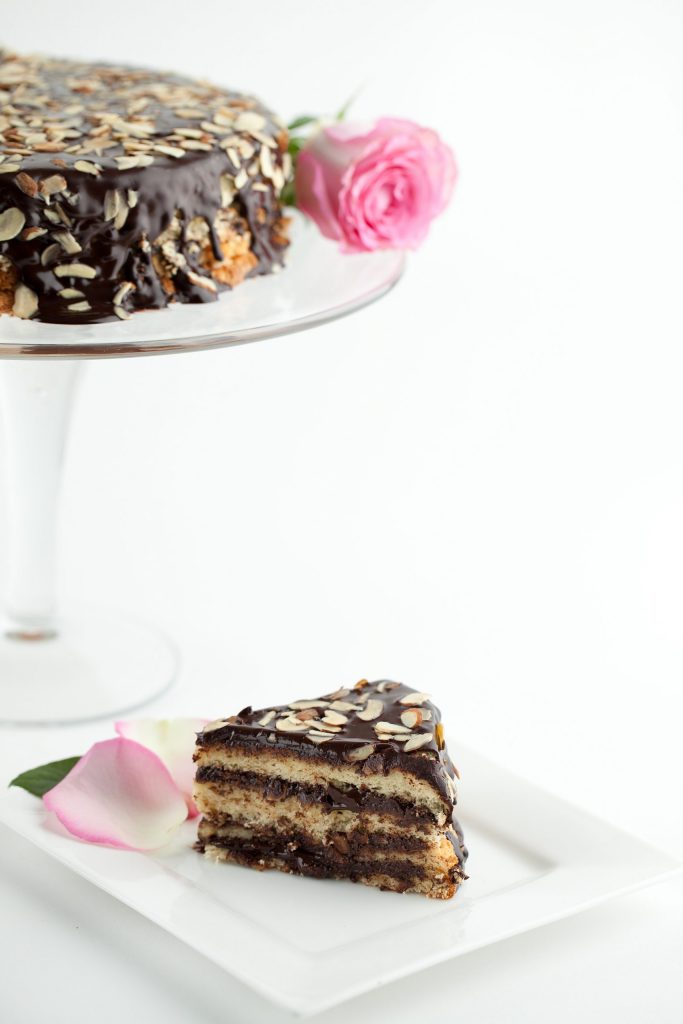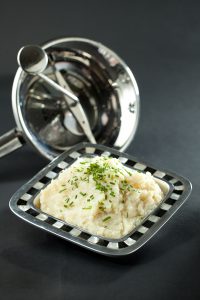A Scalable Seder
A smaller Seder, a quieter table than in years past. For some, they had a Seder for one with their Haggadah as their only company. This was the reality for many last Pesach. As I write this and dream of the large Sedarim of my childhood for thirty or more, with folding tables set up as far as the eye could see, the nagging question persists: what will this year’s Pesach will look like? (And, of course, what is on the menu?)
The recipes herein are for a scalable menu—make one roast, divide and freeze for a smaller crowd. Fish cakes can be doubled or halved. Sponge cake yields three cakes that can be split and layered for larger cakes or kept single for a more modest dessert.
Preparing for Pesach can be redemptive, much like crossing the Yam Suf: anxiously nerve-racking while at the same time incredibly hopeful. To come out of darkness with faith that something good is waiting for us on the other side is something we can all feel, especially this year. Here’s to preparing with hopefulness and joy, and a berachah to appreciate those at your holiday table—big or small!
Herbed Fish Cakes with Lemon-Horseradish Sauce
Yields 15 fish cakes or 22 mini fish cakes
A nice alternative to gefilte fish, these fish cakes are fresh and flavorful. The raw patties can be prepared a day ahead and refrigerated. To refresh and reheat cooked cakes, warm in a single layer on a baking sheet until hot and re-crisped.
Fish Cakes
1 small or ½ large onion, quartered
1¼ pounds skinless cod fillets, cut into chunks
⅓ cup packed fresh Italian parsley
⅓ cup packed fresh dill
1¼ teaspoons coarse kosher salt
½ teaspoon coarsely ground black pepper
1 egg
⅓ cup matzah meal or 1 riced potato
¾ cup vegetable oil or more as needed
Lemon-Horseradish Sauce
½ cup mayonnaise
3 scallions, thinly sliced
½ teaspoon grated lemon peel (from ½ lemon)
Juice of 1 lemon
2-3 teaspoons prepared white horseradish
Kosher salt, to taste
Freshly ground black pepper, to taste
Line a baking sheet with waxed paper or parchment; set aside.
Place quartered onion in a food processor fitted with an “S” blade. Using/on off turns, pulse processor until coarsely chopped. Add fish, parsley, dill, salt and pepper and repeat until finely chopped—do not puree to paste. Transfer to a medium bowl. Add egg and matzah meal, mixing until well blended. Using wet hands, form mixture into round cakes. Arrange on prepared baking sheet. (Can be made one day ahead. Cover and chill.)
To make the sauce, whisk together all ingredients in a small bowl until smooth.
Heat oil in a large skillet over medium heat. Working in batches, fry cakes until nicely browned on each side and opaque in center, about 4 minutes per side (less time for mini cakes). Transfer to platter. Serve warm or at room temperature with Lemon-Horseradish Sauce over a bed of mixed greens.
Spiced French Roast with Dried Fruits
Yields 6-8 servings
This braised meat is perfect for Seder night, and is packed with flavor after marinating in an aromatic spice rub overnight. This recipe can be used interchangeably with brisket. Amounts double easily for a larger cut of meat.
2 teaspoons coarse kosher salt
1 teaspoon ground coriander
¾ teaspoon ground cumin
½ teaspoon ground black pepper
1 teaspoon ground cinnamon
¼ teaspoon ground nutmeg
½ teaspoon ground allspice
1 (3-pound) French roast
2-3 tablespoons canola or vegetable oil
2 medium onions, sliced (about 3 cups)
4 garlic cloves, peeled and chopped
1 cup dry red wine
2 small or 1 large parsnip, peeled and cut into 1-inch pieces
2 small or 1 large carrot, peeled and cut into 1-inch pieces
½ cup whole pitted prunes
½ cup dried apricots
2 tablespoons water
1½ tablespoons honey
1 tablespoon tomato paste
Chopped parsley for garnish
Combine salt, coriander, cumin, black pepper, cinnamon, nutmeg and allspice together in small bowl. Arrange roast in large roasting pan; rub spice mixture evenly over both sides. Cover and refrigerate overnight.
Preheat oven temperature to 325°F. Heat 2 tablespoons of canola oil in a very large skillet over high heat. Carefully place roast in the skillet, and brown for 1-2 minutes per side, turning once. Remove roast from pan and transfer to a plate; set aside.
Lower heat to medium and add another tablespoon of oil to the pan if pan looks dry. Add onions and garlic to the pan and sauté, stirring often and scraping up the browned bits at the bottom of the pan. Sauté for about 5-6 minutes, or until translucent. Pour wine into the pan and deglaze, scraping up the browned bits at the bottom of the pan. Bring to a boil and simmer for 1-2 minutes. Place mixture in the bottom of the roasting pan, then place roast on top, fat side up. Surround roast with parsnips, carrots, prunes and apricots.
In a separate small bowl, mix together water, honey and tomato paste. Stir to blend and then pour over the top of the roast, spreading to cover. Cover pan tightly with foil and bake until tender, about 2½ hours. Allow meat to rest and cool, about 30 minutes.
Transfer roast to a cutting board or work surface. Using a very sharp carving knife, thinly slice roast across the grain on a slight diagonal; replace slices back in the roasting pan. Place vegetables around meat and cover with pan juices. Cover and reheat before serving time. Transfer to a serving platter, garnish with chopped parsley and serve.
Do Ahead: This can be made 2 days ahead. Slice cold; re-warm covered in 350°F oven for 20-30 minutes.
Serving Options: For a thicker sauce, transfer cooking liquid into a small saucepan and bring to a simmer over medium heat for about 15-20 minutes, reducing until thickened to desired consistency.
Celeriac & Potato Puree
Yields 6 servings
Purees are wonderful as a background accompaniment or side dish, allowing the full flavor of the pureed vegetables to come through. You can also make this with kohlrabi instead of celeriac for a nice variation.
1 large celeriac (a.k.a. celery root), peeled, and cut into chunks
4 large or 6 small potatoes, peeled and cut into chunks
1-2 tablespoons butter or olive oil
Kosher salt and freshly ground black pepper, to taste
fresh minced herbs, e.g. dill, parsley (optional)
Fill a large pot with salted water. Place over medium-high heat and bring to a rolling boil. Add celeriac and potatoes. Bring back to a boil and simmer for about 20-25 minutes, or until celeriac is tender and easily pierced with a fork. Remove from heat. Using a slotted spoon, remove celeriac and potatoes (reserve some of the cooking water), transferring to the bowl of a food mill fitted with a medium blade (alternatively, you can use a food processor fitted with an “S” blade. Process until pureed). Rotate the food mill until all of the celeriac and potatoes are pureed.
Transfer to a mixing bowl. Add butter or olive oil and stir to dissolve and blend. Add a little of the reserved cooking water back only as needed to thin consistency if too thick. Season to taste with plenty of salt and pepper and herbs if desired.
Roasted Garlic Variation: For a stronger flavor, add 2 roasted garlic cloves (peel removed) to the food mill prior to pureeing.
Basic Passover Almond Sponge Cake
1 basic sponge cake, 3 amazing variations. This recipe yields 3 (9-inch) round cakes, so you can make an assortment of cakes for Pesach in one shot.
12 eggs, separated
1¾ cups sugar
½ teaspoon grated lemon rind (optional)
½ cup orange juice
1¼ cup almond meal (ground almonds) or 1 cup matzah cake meal
¾ cup potato starch
Pinch of salt
Preheat oven to 350°F. Grease 3 (9-inch) round cake pans. Cut 3 (9-inch) circles of parchment paper and line bottoms of pans; set aside.
Place egg yolks and sugar in a large mixing bowl. Using standing mixer or electric beaters, beat on medium-high speed until the mixture becomes thick and pale yellow in color. Add the lemon rind and orange juice, mixing until well blended. Add the almond meal and potato starch to the egg yolk mixture, beating until well blended and mixture is smooth. Set aside.
In a separate large, dry mixing bowl, beat the egg whites and salt until stiff peaks form. Gently fold half of the egg whites into the yolk mixture. When the egg whites are incorporated, repeat with the remaining egg whites.*
Pour batter into prepared baking pans. Bake for 25-30 minutes or until toothpick comes out clean when testing.
*If using Apple Cake variation, continue with variation directions below.
Toasted Almond & Chocolate Ganache Layer Cake
2 (9-inch) Almond Sponge Cakes (recipe above)
20 oz. bittersweet chocolate, coarsely chopped
1½ cups strong, brewed hot coffee
3 egg yolks
1½ teaspoon vanilla extract (optional)
6 oz. sliced almonds
Place hot coffee and chopped chocolate in a medium mixing bowl and set over a saucepan filled halfway with simmering water over medium-low heat. Whisk together until chocolate is melted and mixture is smooth. Remove bowl from saucepan. Remove 1-2 tablespoons of chocolate mixture and gently mix with yolks in a small bowl to temper; then pour tempered eggs into the chocolate mixture. Add vanilla and use electric beaters to beat until ganache is thick and cool, about 5 minutes.
Preheat oven to 325°F. Spread almonds in a single layer on a baking sheet and bake for 10-12 minutes or until just turning golden color.
Use a plastic knife to loosen edges of sponge cakes. Carefully remove cakes by inverting over a dinner plate; then gently peel off parchment paper. Using a long serrated knife (like a bread knife) with a sawing motion, carefully start cutting each cake horizontally into two even cake layers. The easiest way to do this is evenly is by sawing a little, then rotating the cake, then sawing a little more, continuing until the knife has gone the whole way around and cut through to form two layers.
Repeat with the second cake.
Place first layer on a cake platter or round. Pour about ¼ cup ganache over cake layer, using a spatula to spread evenly if needed. Sprinkle with a handful of toasted almonds. Cover with second cake layer. Repeat with ganache and almonds and remaining cake layers. To finish, pour ganache over top and sides of cake (do not frost—let chocolate drip down sides). Sprinkle remaining toasted almonds over top of cake. Refrigerate and chill until serving time.
Apple Cake Variation
For each (9-inch) round cake, prepare 2 apples—cored, peeled and sliced. Place half of the cake batter in the cake pan, place a layer of sliced apples over the batter, then cover with remaining batter. Bake for 40-50 minutes or until toothpick comes out clean
Strawberry Shortcake Variation
Can be made with 1 or 2 round cakes (depending on how tall you want it)
For each round cake:
1 cup heavy cream
1 tablespoon sugar
1 pint strawberries, hulled and sliced
Whip heavy cream and sugar in a mixing bowl with electric beaters until stiff peaks form. Set aside.
With a long, serrated knife, carefully slice the cake into two equal layers (as per the Toasted Almond & Chocolate Ganache Layer cake variation directions above). Spread half of the whipped cream over the top of one of the layers. Place half of the sliced strawberries in an even layer on top of the whipped cream, and cover with the second cake layer. Repeat with remaining whipped cream (and remaining cake layers, if using). Arrange remaining sliced strawberries on top decoratively. Refrigerate until serving time.
Naomi Ross is a cooking instructor and food writer, and the culinary director at Apron Masters Kitchen in Woodmere, New York. She teaches classes throughout the tri-state area and writes articles connecting good cooking and Jewish inspiration.



